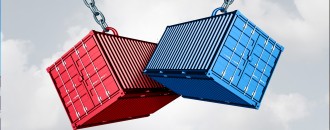
Freight corridor to reduce traders transaction cost, spur exports
The Dollar Business Bureau  Upcoming dedicated freight corridors, linking various parts of India, will enhance export competitiveness of traders across the country by reducing traffic congestion and transaction cost. The government has formed a company - Dedicated Freight Corridor Corporation of India Ltd (DFCCIL) – to develop a mega commercial railway corridor by 2017. According to experts, the step has strategic importance for the Indian government to regain railways’ lost freight share, decongest existing passenger lines, and accelerate industrial growth. Despite having the world’s largest railways network with 115,000 kms of track route, Indian Railways’ share in freight movement declined from 86% to 35.5% in the last 50 years. The upcoming freight corridor project is expected to give impetus to the economic growth. However, any disruption or delay in project execution can cost the country dearly. “The project would support export competitiveness by reducing transaction cost by providing uninterrupted traffic movements at a higher speed,” said India Ratings and Research (Ind-Ra) in its recent study report. Of the total estimated project cost of Rs 733.92 billion according to concession agreement, 36.34% is meant for the eastern corridor and the remaining 63.66% for the western corridor. In the current financial year, the government has spent Rs150 million and is expected to spend Rs 230 million by the year-end. The entire project has been divided into two parts—eastern corridor and western corridor. The eastern corridor is funded by World Bank’s US$ 2.725bn loan and the western corridor by Japan International Cooperation Agency’s (JICA) Special Terms of Economic Partnership Loan of Japanese yen 677billion. Though JICA’s loan is hedged by the government at a rate of 6.8%, DFCCIL is exposed to the risk of loss in foreign exchange as the World Bank loan is not hedged and it will be serviced in rupee equivalent to US$ at prevailing rates. Though the project is expected to be fully operational by 2019, it faces the risk of delay due to the involvement of complex construction spread over difficult terrain, say experts. Till December last year, around 79.1% of land has already been acquired, of which 32.9% (1,100km) has been awarded for construction. In the current financial year, another 750-km of civil contracts and 1,300-km of system contracts are likely to be awarded. Also, work on around 55-km of eastern corridor is expected to be completed during this year. As per an agreement between the railway ministry and DFCCIL, the government can offload its 70% of freight traffic with the commencement of operations in 2017. DFCCL is assigned to construct, operate and maintain the two dedicated freight lines. The project will also promote other development activities along the corridor in Uttar Pradesh, West Bengal, Jharkhand, Rajasthan and Gujarat. Industrial hubs near Kanpur, Ludhiana, Mumbai, Vapi, Ahmedabad, Gandhidham, Jaipur and Delhi can see the setting up of logistics parks and other such facilities. Spread over more than 1,800 kms, the eastern corridor will cover six states. This corridor consists of a double-track stretch between Dankuni (West Bengal) and Khurja (Uttar Pradesh) and a single-track segment of 447km between Ludhiana in Punjab and Khurja in UP. The 1483-km stretch of western corridor will cover four states with a double-line track linking Jawaharlal Nehru Port Trust to Dadri via Vadodara-Ahmedabad-Palanpur-Phulera-Rewari. DFCCIL will also help the country in improving its carbon footprints. According to another study, India has higher reliance on roads for freight movement than China and US. A report by the environment ministry shows that in 2007, road transport accounted for 87% of the total carbon dioxide equivalent emissions from the transport sector (142.04 million tonnes of carbon dioxide) and railways accounting for only 5%. The freight corridors will be able to accommodate heavier loads and at higher speeds. The traffic on the eastern corridor is expected to be dominated by coal supply from eastern coalfields. The western corridor will see movement of containers from JNPT and Mumbai port in Maharashtra and ports of Pipavav, Mundra and Kandla in Gujarat. DFCCIL hopes to commence commercial operations from 2017. Till then, operating expenditure along with the interest during construction is being capitalised. Interest income is the only source of income of the corporation. It grew 123.42% year-on-year to Rs 1.87 bn in 2013. The entity had an outstanding external debt of Rs 9.86 bn till March 2014.
Upcoming dedicated freight corridors, linking various parts of India, will enhance export competitiveness of traders across the country by reducing traffic congestion and transaction cost. The government has formed a company - Dedicated Freight Corridor Corporation of India Ltd (DFCCIL) – to develop a mega commercial railway corridor by 2017. According to experts, the step has strategic importance for the Indian government to regain railways’ lost freight share, decongest existing passenger lines, and accelerate industrial growth. Despite having the world’s largest railways network with 115,000 kms of track route, Indian Railways’ share in freight movement declined from 86% to 35.5% in the last 50 years. The upcoming freight corridor project is expected to give impetus to the economic growth. However, any disruption or delay in project execution can cost the country dearly. “The project would support export competitiveness by reducing transaction cost by providing uninterrupted traffic movements at a higher speed,” said India Ratings and Research (Ind-Ra) in its recent study report. Of the total estimated project cost of Rs 733.92 billion according to concession agreement, 36.34% is meant for the eastern corridor and the remaining 63.66% for the western corridor. In the current financial year, the government has spent Rs150 million and is expected to spend Rs 230 million by the year-end. The entire project has been divided into two parts—eastern corridor and western corridor. The eastern corridor is funded by World Bank’s US$ 2.725bn loan and the western corridor by Japan International Cooperation Agency’s (JICA) Special Terms of Economic Partnership Loan of Japanese yen 677billion. Though JICA’s loan is hedged by the government at a rate of 6.8%, DFCCIL is exposed to the risk of loss in foreign exchange as the World Bank loan is not hedged and it will be serviced in rupee equivalent to US$ at prevailing rates. Though the project is expected to be fully operational by 2019, it faces the risk of delay due to the involvement of complex construction spread over difficult terrain, say experts. Till December last year, around 79.1% of land has already been acquired, of which 32.9% (1,100km) has been awarded for construction. In the current financial year, another 750-km of civil contracts and 1,300-km of system contracts are likely to be awarded. Also, work on around 55-km of eastern corridor is expected to be completed during this year. As per an agreement between the railway ministry and DFCCIL, the government can offload its 70% of freight traffic with the commencement of operations in 2017. DFCCL is assigned to construct, operate and maintain the two dedicated freight lines. The project will also promote other development activities along the corridor in Uttar Pradesh, West Bengal, Jharkhand, Rajasthan and Gujarat. Industrial hubs near Kanpur, Ludhiana, Mumbai, Vapi, Ahmedabad, Gandhidham, Jaipur and Delhi can see the setting up of logistics parks and other such facilities. Spread over more than 1,800 kms, the eastern corridor will cover six states. This corridor consists of a double-track stretch between Dankuni (West Bengal) and Khurja (Uttar Pradesh) and a single-track segment of 447km between Ludhiana in Punjab and Khurja in UP. The 1483-km stretch of western corridor will cover four states with a double-line track linking Jawaharlal Nehru Port Trust to Dadri via Vadodara-Ahmedabad-Palanpur-Phulera-Rewari. DFCCIL will also help the country in improving its carbon footprints. According to another study, India has higher reliance on roads for freight movement than China and US. A report by the environment ministry shows that in 2007, road transport accounted for 87% of the total carbon dioxide equivalent emissions from the transport sector (142.04 million tonnes of carbon dioxide) and railways accounting for only 5%. The freight corridors will be able to accommodate heavier loads and at higher speeds. The traffic on the eastern corridor is expected to be dominated by coal supply from eastern coalfields. The western corridor will see movement of containers from JNPT and Mumbai port in Maharashtra and ports of Pipavav, Mundra and Kandla in Gujarat. DFCCIL hopes to commence commercial operations from 2017. Till then, operating expenditure along with the interest during construction is being capitalised. Interest income is the only source of income of the corporation. It grew 123.42% year-on-year to Rs 1.87 bn in 2013. The entity had an outstanding external debt of Rs 9.86 bn till March 2014.
May 18, 2015 | 4:12 pm IST.






 to success.
to success.